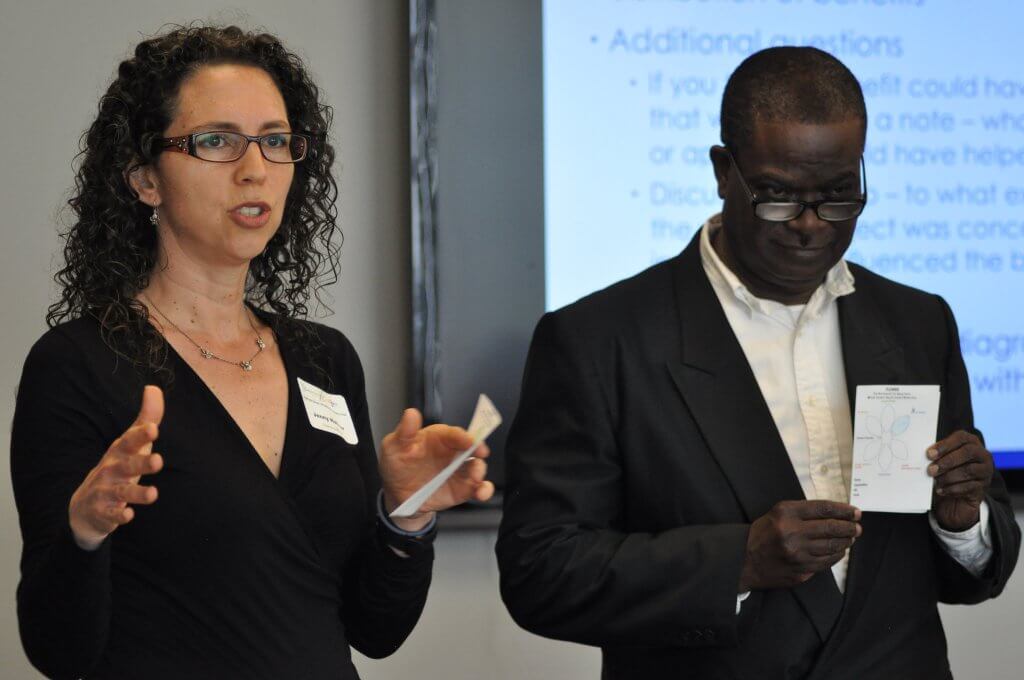Putting Equity at the Center of the Fight to Protect the Climate: Five practical lessons
By
Elizabeth Sawin
August 26, 2016
 Fostering effective, inclusive collaboration can be a powerful leverage point for addressing climate change, but it requires a focus on relationships, values, and a bigger picture.
Fostering effective, inclusive collaboration can be a powerful leverage point for addressing climate change, but it requires a focus on relationships, values, and a bigger picture.
Some of the most promising climate solutions have the potential to benefit health, well-being, and social justice while reducing greenhouse gas emissions, but there’s a catch. Implementing these solutions isn’t simple. It requires collaborating in new ways, pooling knowledge, and sharing resources.
Earlier this summer we completed the first phase of a project on Equity and Green Infrastructure in Atlanta with our partners at Partnership for Southern Equity, Pontifex Consulting, and Anderson Smith Consulting. The work is giving us new ideas about what it takes to address climate change as a ‘whole system.’ Here are five elements we are finding important. We’d love your input: Do these elements show up in your own work? What would you add to this list of five?
**Invest in relationships and shared values. **In Atlanta we brought together a group of people whose ‘day jobs’ ranged from health to water to community advocacy to city government. The quest to scale up green infrastructure asks something different from each of them. The ‘prize’ looks different too: clean water for some, economic development without displacement for others, less flooding on the streets for others. What they have in common is a set of values uncovered in a process of conversation and soul searching that are both deeply personal and explicitly shared. Despite difference in circumstances, resources, life experience, and professional role, members of the group know they can count on each other’s commitment to a vision of green infrastructure as a means towards greater equity, well-being, and community empowerment.
**Be ready to make space for many issues. **Often one topic brings people to the conversation, but as the intersections between issues start to rise to the surface, people make room in their hearts and in their minds for issues that may not have been prominent for them in the past. The clean energy technical expert starts to understand what it’s like to be unable to pay a utility bill. The health expert starts to understand how future climate change threatens current health gains. The participants in our projects tend to already be pressed for time, and we are clear we aren’t asking them to take on additional issues in their work. Instead we are encouraging everyone to look for how shifts in work they are already doing could address multiple issues together.
**Feed the hunger for a bigger picture. **Many participants arrived at our project frustrated with ‘silos’ and obstacles to collaboration in their daily professional lives. Some depend on donors who only fund in narrow issue areas, others work for government agencies with narrow jurisdictions, others are frustrated because they can’t find ways to bring community expertise to decision making. The possibility of forging relationships that breakdown these silos is very appealing to many participants, and many also say that the chance to get to know and learn from people with other views and experiences is a source of satisfaction and motivation to keep coming back to our meetings. (We have found both computer simulation and systems diagrams especially helpful in building this bigger picture, more on that in another blog post soon!)
Don’t skip the hard stuff. Participants talk about the ‘safe space’ we have created where people can disagree, grapple with ideas, and be uncertain. The development of shared values contributes to that sense of safety. It also grows out moments of disagreement, when people listen and acknowledge the perspective of others in the group. Racial and class equity, the transparency of government, and the legacy of past decisions that benefit some and leave others behind are all present in any conversation that explores co-benefits in climate, health, and well-being. Much of the time, our silo-ed institutions and segregated neighborhoods protect us from facing these challenging conversations, but finding our shared power to implement solutions requires we engage them.
**Time, patience, and acceptance of uncertainty will be required. **This lesson follows naturally from the first four. Any process that builds new relationships, searches for shared values and a bigger picture, and doesn’t shy away from difficult conversations is going to follow a path that is evolving, dynamic, and emergent. Forging new connections and bringing into view a bigger picture will create ripples. Resources will be shared in new ways, invitations will pass in new directions, and new questions will be asked in unexpected places. But where, when, and how this plays out will depend upon who shows up and what is needed in that place at that time. So, be prepared to cultivate patience and tolerance for periods of confusion, as a wisdom that is larger than that of any individual group member begins to develop.

 Fostering effective, inclusive collaboration can be a powerful leverage point for addressing climate change, but it requires a focus on relationships, values, and a bigger picture.
Fostering effective, inclusive collaboration can be a powerful leverage point for addressing climate change, but it requires a focus on relationships, values, and a bigger picture.